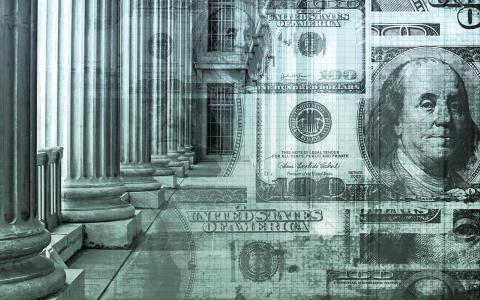
Risk parity funds.
Volatility-targeting programs.
Statistical arbitrage. Sometimes the US stock market seems like a giant science project, one that can quickly turn hazardous for its human inhabitants.
You didn’t need an engineering degree to tell something was amiss Monday.
While it’s impossible to say for sure what was at work when the Dow Jones Industrial Average fell as much as 1,597 points, the worst part of the downdraft felt to many like the machines run amok.
For 15 harrowing minutes just after 3 p.m. in New York a deluge of sell orders came so fast that it seemed like nothing breathing could’ve been responsible.
The result was a gut check of epic proportion for investors, who before last week had been riding one of the most peaceful market advances ever seen.
The S&P 500, which last week capped a record streak of never falling more than 3% from any past point, ended the day down 4.1%, bringing its loss since last Monday to 7.8%.
“We are proactively calling up our clients and discussing that a 1,600-point intraday drop is due more to algorithms and high-frequency quant trading than macro events or humans running swiftly to the nearest fire exit,” said Jon Ulin, of Ulin & Co. Wealth Management in Boca Raton, Fla., in an email.
Futures on the Dow were down 0.5% as of 6:12 a.m. in New York, while those on the S&P 500 were up 0.2%.
Rational, Yet Harrowing
To be sure, not all of the rout requires inhuman agency to explain. Markets are jittery.
Bond yields had been surging and stock valuations are approaching levels last seen in the internet bubble. Much of today’s selloff was perfectly rational, if harrowing -- particularly coming after last week’s plunge in which the Dow fell 666 points on Friday.
Observers looking for an electronic villain trained most of their attention on the roughest part of the tumble, a 15-minute stretch starting about an hour before the close. That’s when an orderly selloff snowballed, taking the Dow from down about 700 points to down a whopping 1,600. It quickly recovered.
“What was frightening was the speed at which the market tanked,” said Walter “Bucky” Hellwig, Birmingham, Alabama-based senior vice president at BB&T Wealth Management, who helps oversee about $17 billion.
“The drop in the morning was caused by humans, but the free-fall in the afternoon was caused by the machines. It brought back the same reaction that we had in 2010, which was ‘What the heck is going on here?”
It may never be clear what accelerated the tumble -- people still aren’t sure what caused the flash crash on May 6, 2010.
Unlike then, most of the theorizing about today’s events centered not on the market’s plumbing or infrastructure, but on the automated quant strategies that gained popularity with the advent of electronic markets last decade.
Particular suspicion landed on trading programs tied to volatility, mathematical measures of which exploded as the day progressed.
How pervasive such strategies are in the US stock market is a point of debate, though everyone agrees they’re big.
After a similar downdraft struck equity markets in August 2015, JPMorgan Chase said shifting signals from volatility and share prices threatened to unleash $300 billion of selling pressure on equities.
Since then, it’s become de rigueur to implicate systematic strategies whenever a selloff lands on investors.
The firm’s chief derivatives strategist, Marko Kolanovic, said signals sent to systematic traders, first by last week’s slowdown in the rally and then the Cboe Volatility Index, played a central role in Monday’s downdraft.
“Midday today, short-term momentum turned negative, resulting in selling from trend-following strategies,” he wrote in a note to clients.
“Further outflows resulted from index option gamma hedging, covering of short volatility trades, and volatility targeting strategies. These technical flows, in the absence of fundamental buyers, resulted in a flash crash at ~3:10 pm today.”
Several securities tied to the VIX volatility index were halted for trading on Tuesday.
The VelocityShares Daily Inverse VIX Short-Term ETN was suspended by Nasdaq, and ProShares Short VIX Short-Term Futures ETF was suspended by NYSE Arca, both pending news.
Theories on how machines interact with share prices have evolved since the days of the Flash Crash, the market rupture of May 6, 2010, in which the Dow average fell about 1,000 points before reversing. Back then the expectation was that something had gone wrong on the electronic exchanges where shares trade -- something that was roundly denied this time.
“There was not a single self-help; there were no outs; there were no fat fingers that we saw,” Doug Cifu, CEO of high-speed trading firm Virtu, told CNBC.
“There were no busted trades, no repricing. It was just an avalanche of orders around 3 o’clock-ish.”
Nowadays the first suspicion alights on computerized traders who operate everywhere.
At the same time, a case can be made that the machines are doing the same thing any human trader would do given a certain set of economic facts, only faster. Inputs into automated strategies sound complicated but often are just versions of signals familiar to earlier generations: momentum indicators that show if an advance is getting ahead of itself or a decline is turning into a plunge.
“There were a lot of stops, old fashioned stops triggered and some algorithm trading,” Scott Wren, senior equity strategist at Wells Fargo Investment Institute Inc., said in an interview on Bloomberg Television.
“This is a technically driven day. You watch the 50-day average. It might be a magnet.”



